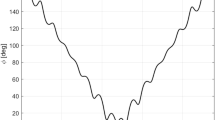Abstract
Successful tracking and detection of resident space objects (RSOs) requires selection of spectral filters that are capable of compensating for the effects of wavelength dependent atmospheric scattering, and material reflectance properties. When operating in an urban environment such as Atlanta, GA the emitted city light pollution is also an important factor. In this study, we perform a multi-spectral optimization for the Georgia Tech Space Object Research Telescope across the visible through infrared spectrum that accounts for atmospheric turbulence, atmospheric transmission, and background sky radiance. The first contribution of this work is the development of a wavelength-dependent performance metric for the detection of RSOs under different atmospheric conditions. The second contribution is the derivation of a simplified model for light pollution that is based on existing astronomy models. This simplified model accounts for double scattering of light and can be used for adding a light pollution component to sky background results that are generated by complex atmospheric simulation tools. The final contribution is the derivation of novel spectral filters that are tuned to the sub-optimal atmospheric seeing conditions of Atlanta, GA and the RSO materials that are considered in this study. While this study is developed for the geographic region of Atlanta, GA and uses simplified bidirectional reflectance distribution models models for spacecraft materials, the framework is generalizable to different geographic regions, weather conditions, and satellite orientations.










Similar content being viewed by others
References
Arora, J.S.: Introduction to Optimum Design. Elsevier (2004)
Berk, A., Anderson, G.P., Bernstein, L.S., Acharya, P.K., Dothe, H., Matthew, M.W., Adler-Golden, S.M., Chetwynd, J.H., Richtsmeier, S.C., Pukall, B., et al.: Modtran4 radiative transfer modeling for atmospheric correction. In: Optical Spectroscopic Techniques and Instrumentation for Atmospheric and Space Research III, vol. 3756, pp 348–354. International Society for Optics and Photonics (1999)
Budding, E., Demircan, O.: Introduction to Astronomical Photometry, vol. 6. Cambridge University Press, Cambridge (2007)
Coder, R., Holzinger, M.: Sizing of a raven-class telescope using performance sensitivities. In: Advanced Maui Optical and Space Surveillance Technologies Conference (2013)
Coder, R.D., Holzinger, M.J.: Multi-objective design of optical systems for space situational awareness. Acta Astronaut. 128, 669–684 (2016)
Coder, R.D., Jaunzemis, A.D., Mathew, M.V., Worthy, J.L., Holzinger, M.J.: Georgia tech space object research telescope. J. Spacecr. Rockets 54(6), 1399–1403 (2017)
Fried, D.L.: Optical resolution through a randomly inhomogeneous medium for very long and very short exposures. JOSA 56(10), 1372–1379 (1966)
Garstang, R.: Night sky brightness at observatories and sites. Publ. Astron. Soc. Pac. 101(637), 306 (1989)
Garstang, R.: Dust and light pollution. Publ. Astron. Soc. Pac. 103(668), 1109 (1991)
Hänel, A., Posch, T., Ribas, S.J., Aubé, M., Duriscoe, D., Jechow, A., Kollath, Z., Lolkema, D.E., Moore, C., Schmidt, N., et al.: Measuring night sky brightness: methods and challenges. J. Quant. Spectrosc. Radiat. Transf. 205, 278–290 (2018)
Hansen, M.P., Malchow, D.S.: Overview of swir detectors, cameras, and applications. In: Thermosense, vol. 6939, p 69390I. International Society for Optics and Photonics (2008)
Holst, G.C., Lomheim T.S.: CMOS/CCD sensors and camera systems (2007)
Ientilucci, E.J., Brown, S.D.: Advances in wide-area hyperspectral image simulation. In: Targets and Backgrounds IX: Characterization and Representation, vol. 5075, pp 110–121. International Society for Optics and Photonics (2003)
Judd, D.B.: Report of us secretariat committee on colorimetry and artificial daylight. Proc. 12th Session CIE 1951(1), 11 (1951)
Marin, C.: Starlight: a common heritage. Proc. Int. Astron. Union 5(S260), 449–456 (2009)
Princeton Instruments: Introduction to scientific ingaas fpa cameras. Technical Report. https://www.princetoninstruments.com/userfiles/files/technotes/Introduction-to-scientific-InGaAs-FPA-cameras.pdf (2019)
Quan, J., Zhang, Q., He, H., Liu, J., Huang, M., Jin, H.: Analysis of the formation of fog and haze in north China plain (ncp). Atmos. Chem. Phys. 11(15), 8205–8214 (2011)
Reyes, J., Cone, D.: Characterization of spacecraft materials using reflectance spectroscopy. In: The Advanced Maui Optical and Space Surveillance Technologies Conference (2018)
Sabol, C., Luu, K. K., Kervin, P., Nishimoto, D., Hamada, K., Sydney, P.: Recent developments of the raven small telescope program. Adv. Astron. Sci. 112, 397–416 (2002)
Schildknecht, T.: Optical astrometry of fast moving objects using ccd detectors. Geod.-Geophys. Arb. Schweiz, No. 49, 49 (1994)
Shell, J.R.: Optimizing orbital debris monitoring with optical telescopes. Tech. rep. Air Force Space Innovation and Development Center Schriver AFB CO (2010)
Shirkey, R.C.: Sky glow from cities: the army illumination model v2. Tech. rep. Army Research Lab, White Sands Missile Range NM (2011)
Treanor, P.J.: A simple propagation law for artificial night-sky illumination. Observatory 93, 117–120 (1973)
Vautard, R., Yiou, P., Van Oldenborgh, G. J.: Decline of fog, mist and haze in europe over the past 30 years. Nat. Geosci. 2(2), 115 (2009)
Acknowledgments
This work has been funded by Georgia Tech Research Institute Internal Research and Development (IRAD) funding.
Author information
Authors and Affiliations
Corresponding author
Additional information
Publisher’s Note
Springer Nature remains neutral with regard to jurisdictional claims in published maps and institutional affiliations.
This article belongs to the Special Topic Section: Advanced Maui Optical and Space Surveillance Technologies (AMOS 2018 & 2019)
Guest Editors: James M. Frith, Lauchie Scott, Islam Hussein
Rights and permissions
About this article
Cite this article
Badura, G.P., Valenta, C.R., Gunter, B. et al. Spectral Performance Optimization of Small-Diameter Telescopes for Space Object Detection. J Astronaut Sci 68, 225–247 (2021). https://doi.org/10.1007/s40295-021-00253-4
Accepted:
Published:
Issue Date:
DOI: https://doi.org/10.1007/s40295-021-00253-4



